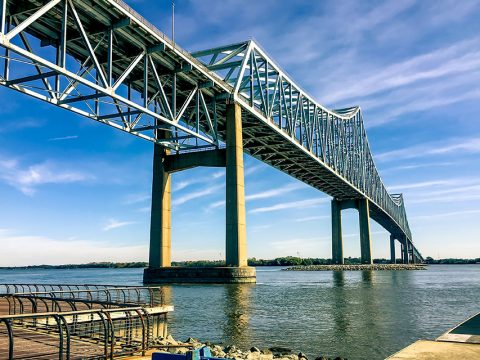- Pioneering Non-Destructive Testing (NDT) Since 1974
- (716) 731-4369
- info@penetradar.com

Asphalt Thickness on Interstate 85
February 3, 2017
Commodore Barry Bridge
February 3, 2017Nondestructive Investigation of the Elmwood Avenue Bridge
Using Ground Penetrating Radar (GPR) & High Resolution Imaging (HRI)
A common repair strategy for existing bridge decks involves the application of an overlay. An overlay serves the dual purpose of restoring ride-ability to the bridge deck pavement and as a barrier to keep out moisture and chlorides, which are known to cause corrosion of reinforcement and delamination. In recent years there has been a trend toward high density concrete and latex modified concrete overlays which are known to perform well in that capacity. However, one of the problems that can occur with rigid overlays is improper bonding or debonding from the deck. This type of occurrence can cause early failure of the overlay which can result in its inability to perform as a waterproofing layer.
The discussion that follows describes how non-destructive methods – ground penetrating radar (GPR) and high resolution imaging (HRI) can be used to identify and quantify defects in a bridge deck such as debonding, surface cracking and delamination and help to identify the cause of defects that are observed at the surface.
The Elmwood Avenue Bridge is a five span structure that crosses the Genesee River in Rochester, New York. Rehabilitation work on this bridge deck was completed in 2014, which involved the removal of the existing overlay, scarification of 0.5 inches of the existing concrete deck and the placement of a new 1.5-inch latex modified concrete overlay. Since the completion of the project, excessive cracking and spalling were observed in the overlay, which was unexpected considering its age. This raised the question as to the cause of this early failure and whether it was related to the overlay, the bonding of the overlay or some occurrence within the deck such as delamination.
Using a combination of ground penetrating radar (GPR) and high resolution imaging (HRI), the objective was to determine the cause of this distress. GPR was used to ascertain the internal condition of the deck by identifying areas of internal defects suchs debonding of the overlay and corrosion induced delamination, and HRI of the surface was performed to document areas of visible distress, which could then be compared to and correlated with internal deck defects.
The GPR inspection of bridge decks is typically performed at highway speeds with an array of non-contacting antennas. In operation, the GPR effectively covers a lane width as the inspection vehicle traverses the bridge deck. Waveforms from the GPR antenna array are collected along with high precision odometer information and GPS for subsequent analysis and detection. The HRI is also collected at highway speed concurrently with GPR. High resolution image frames, along with distance information are captured in a downward view and converted to a plan-view using a special image processing method that is analogous to line scan imaging.
The results of this investigation are shown below. GPR plan-view mappings (Figures 1 & 2) show the locations of debonded overlay, areas of corrosion induced delamination and sound concrete within the bridge deck. Plan-view images of the deck surface, produced by the HRI survey, (Figure 3 & 4) show detailed surface conditions, and areas of visible distress “outlined” to determine the quantity of deck exhibiting visible defects
Debonded Concrete Overlay – Figure 1

Corrosion Induced Concrete Delamination – Figure 2
Surface Distress – Figure 3

High Resolution Surface Imaging – Figure 4

When comparing locations of surface distress with debonded concrete overlay and corrosion induced concrete delamination the results suggest that surface distress was more closely related to the delaminations in the deck than from a debonded overlay. Delamination was most notably observed in Span #4, as was the greatest incidence of surface distress, and while considerable debonding was also detected, it was not confined to any region of the deck and did not correlate to locations of deck surface distress.
In summary, NDT methods such as GPR and HRI not only provide critical information on the condition of structures but can also assist in determining cause of failure and in decision making strategies for bridge deck remediation.
By utilizing cutting-edge non-destructive testing technologies, Penetradar can provide you with the information you need to make the best engineering decisions. Contact us today to discuss your next project.






